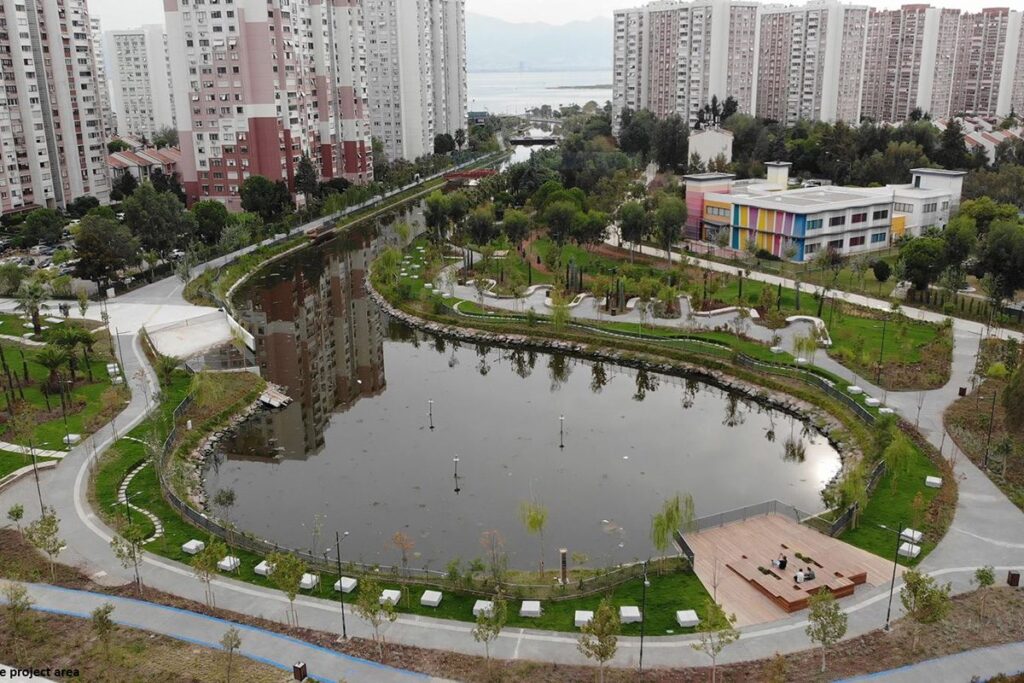ENVIRONMENT AND CLIMATE CHANGE
Renaturing Izmir’s: green axes & nature-based solutions to adapt to heat

With its large population and expanding urban areas, Izmir offers an opportunity to apply European re-naturing strategies to cities facing the challenges of the fast-urbanizing world. The interventions focus mainly on creating green corridors and on decreasing the city’s temperatures.
Challenges addressed
• Climate action: Mitigation, adaptation, and coastal resilience.
• Resource management: Water, air quality, and green space conservation (biodiversity).
• Urban development: Regeneration, participatory planning, and governance.
• Social outcomes: Public health, social justice, cohesion, and green job opportunities.
Main objectives
• Mitigate the effects of climate change through nature-based solutions that reduce CO₂ emissions and urban temperatures.
• Improve air quality and water management through green infrastructure and sustainable drainage systems.
• Increase urban biodiversity by creating ecological corridors and green spaces that connect the city with nature.
• Encourage citizen participation in environmental initiatives to raise awareness about sustainability and promote community well-being.
External resources
Facts
Project type Nature-based solution urban project
Partners Urban Green Up, Fundación Cartif
Beneficiaries Izmir municipality
Dates June 2017 – May 2022
Website Izmir Re-naturing through NbS
Project description
Izmir’s strategy to adapt to heat focuses on re-naturing urban areas through nature-based solutions aim to reduce temperatures, improve air quality, and create more resilient urban spaces. The so-called Urban Green Up project is a 5-year project that combines practical implementation of nature-based solutions (NBS) with social, ecological, and economic research, considering NBS as an innovative way to address the many climate challenges urban areas are facing.
The city is implementing actions such as creating parklets, arboreal zones around car parks, and planting 4,800 heat-resistant trees, with its large population and expanding urban areas, Izmir is a clear example on how cities can face the upcoming climate change challenges such the increasing city heat temperatures.
Additionally, smart soil technologies, permeable pavements, and green-covered shelters are incorporated to improve urban sustainability. Water management interventions, such as retention ponds and grassed swales, are also utilized to reduce flood risks, enhance water quality, and promote biodiversity.
Impact and results
Urban Re-naturing and Cooling
• A green cycle route will benefit 1.2 million citizens, restoring riversides and enhancing connectivity.
• Tree planting and green infrastructure will lower CO₂ emissions by 46 tons/year and ambient summer temperatures by 2–5°C, while increasing biodiversity.
• Shaded resting areas and green shelters will improve comfort for citizens and enhance green cover by 75%.
Water Management and Flood Prevention
• Sustainable drainage systems and eco-friendly riverbanks will capture 165 tons of water/year, prevent flash floods, and support 300,000 new urban dwellers annually.
Singular Green Infrastructure
• Biochar and pollinator-friendly measures will reduce pollution, mitigate the heat island effect by up to 1.5°C, and increase biodiversity by 45%.
• Urban farming and vertical/horizontal GIs will provide water savings, CO₂ capture, and temperature reductions.
Education and Engagement
• Educational programs like the “Laboratory of the Future” and Bio-Boulevard will engage 840,000 visitors, fostering awareness on climate change and biodiversity.
• Community initiatives, including urban farming, women cooperatives, and events, will directly involve over 500,000 citizens.
Technology and Support
• Platforms for monitoring and mentoring will engage 60,000 citizens, promoting ecological awareness and solutions.
Publications & main documents
RELATED CONTENT
Sorry, no posts matched your criteria.


